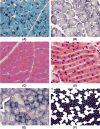Approach to the diagnosis of congenital myopathies
- PMID: 24456932
- PMCID: PMC5257342
- DOI: 10.1016/j.nmd.2013.11.003
Approach to the diagnosis of congenital myopathies
Abstract
Over the past decade there have been major advances in defining the genetic basis of the majority of congenital myopathy subtypes. However the relationship between each congenital myopathy, defined on histological grounds, and the genetic cause is complex. Many of the congenital myopathies are due to mutations in more than one gene, and mutations in the same gene can cause different muscle pathologies. The International Standard of Care Committee for Congenital Myopathies performed a literature review and consulted a group of experts in the field to develop a summary of (1) the key features common to all forms of congenital myopathy and (2) the specific features that help to discriminate between the different genetic subtypes. The consensus statement was refined by two rounds of on-line survey, and a three-day workshop. This consensus statement provides guidelines to the physician assessing the infant or child with hypotonia and weakness. We summarise the clinical features that are most suggestive of a congenital myopathy, the major differential diagnoses and the features on clinical examination, investigations, muscle pathology and muscle imaging that are suggestive of a specific genetic diagnosis to assist in prioritisation of genetic testing of known genes. As next generation sequencing becomes increasingly used as a diagnostic tool in clinical practise, these guidelines will assist in determining which sequence variations are likely to be pathogenic.
Keywords: Congenital myopathy; Diagnosis; Guidelines.
Copyright © 2013 The Authors. Published by Elsevier B.V. All rights reserved.
Conflict of interest statement
We declare that the authors have no conflict of interest or financial relationship with this work.
Figures



References
-
- Laing NG, Wallgren-Pettersson C. 161st ENMC International Workshop on nemaline myopathy and related disorders, Newcastle upon Tyne, 2008. Neuromuscul Disord. 2009;19:300–5. - PubMed
-
- Nowak KJ, Wattanasirichaigoon D, Goebel HH, et al. Mutations in the skeletal muscle alpha-actin gene in patients with actin myopathy and nemaline myopathy. Nat Genet. 1999;23:208–12. - PubMed
-
- Goebel HH, Piirsoo A, Warlo I, et al. Infantile intranuclear rod myopathy. J Child Neurol. 1997;12:22–30. - PubMed
-
- Bornemann A, Petersen MB, Schmalbruch H. Fatal congenital myopathy with actin filament deposits. Acta Neuropathol. 1996;92:104–8. - PubMed
-
- Laing NG, Clarke NF, Dye DE, et al. Actin mutations are one cause of congenital fibre type disproportion. Ann Neurol. 2004;56:689–94. - PubMed
Publication types
MeSH terms
Grants and funding
LinkOut - more resources
Full Text Sources
Other Literature Sources
Medical
Research Materials
Miscellaneous

